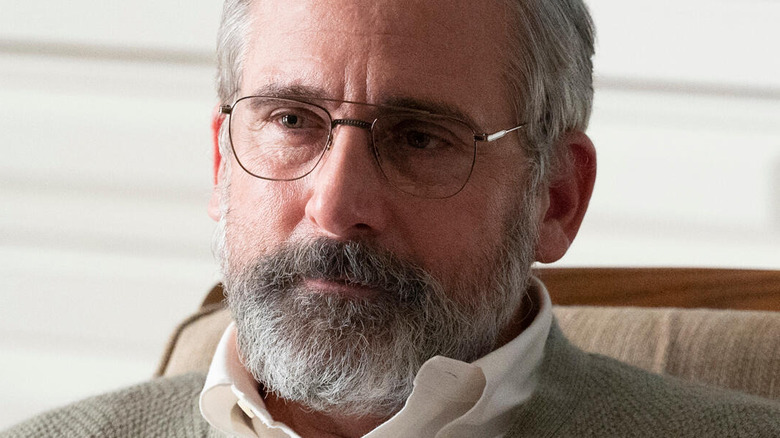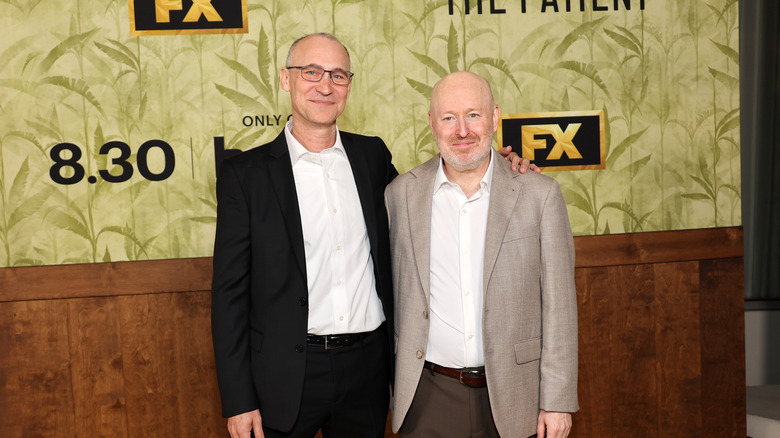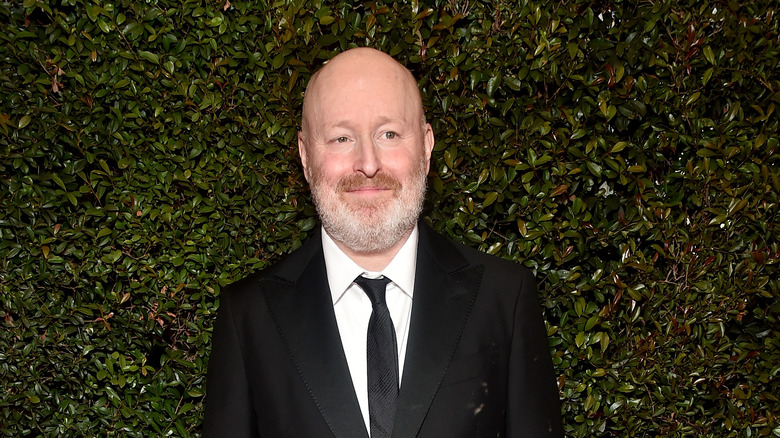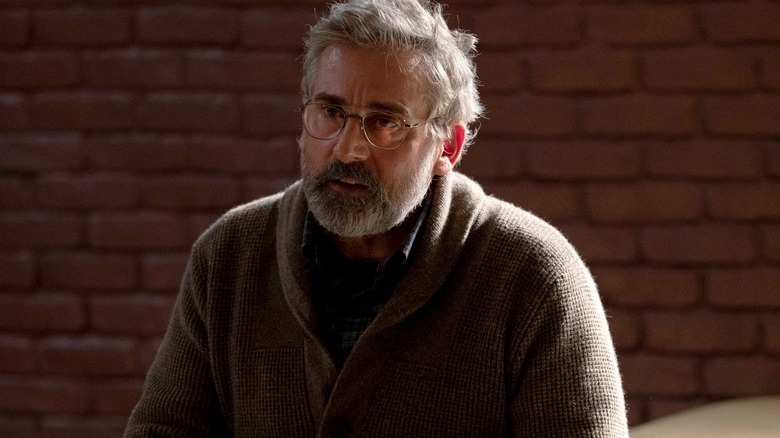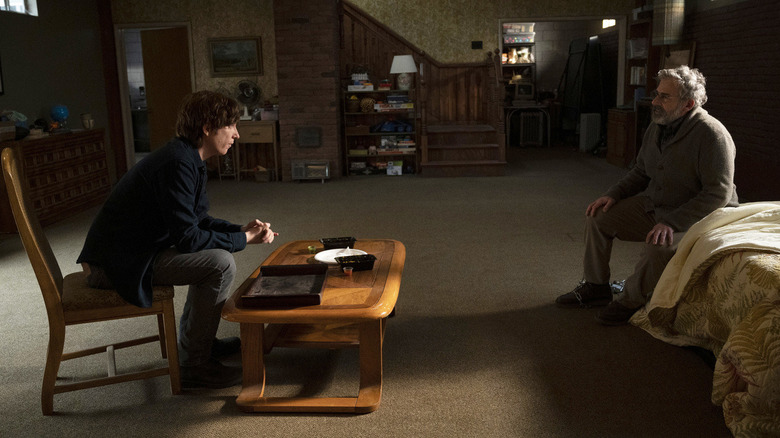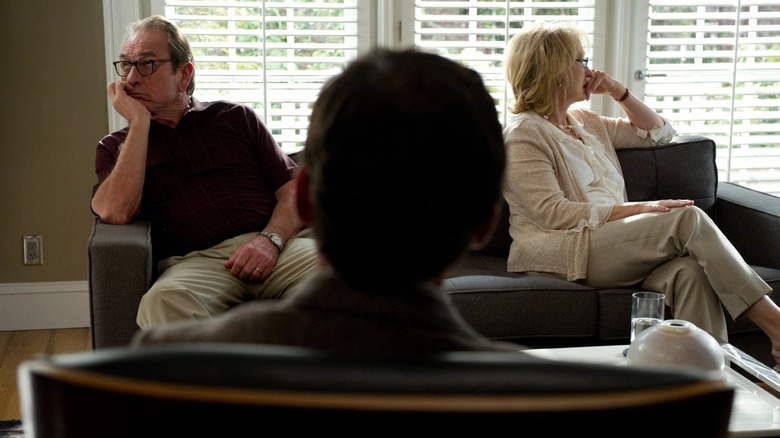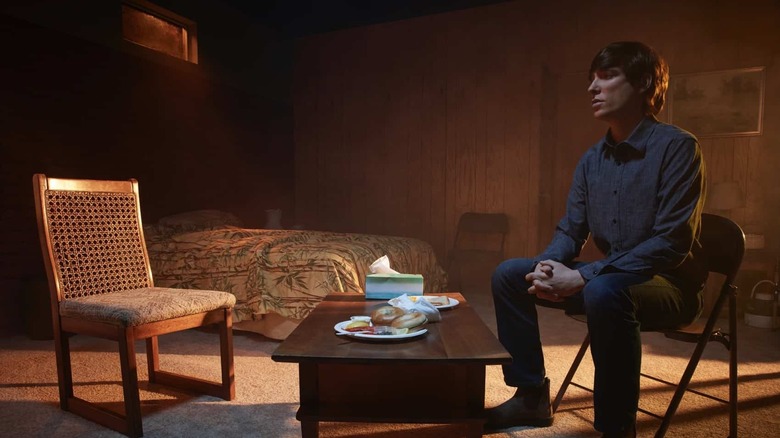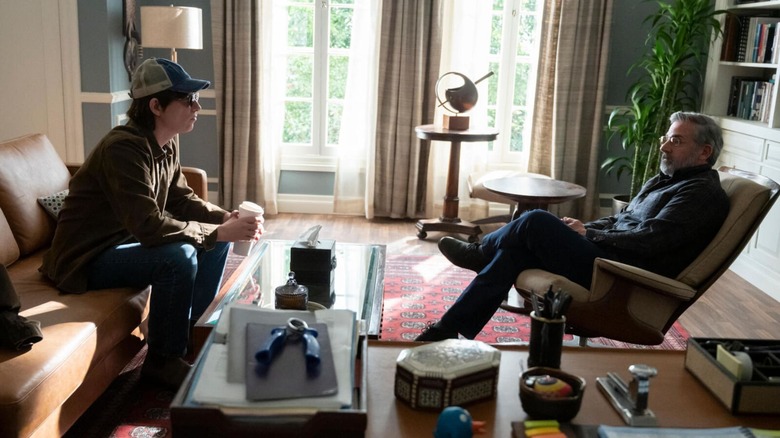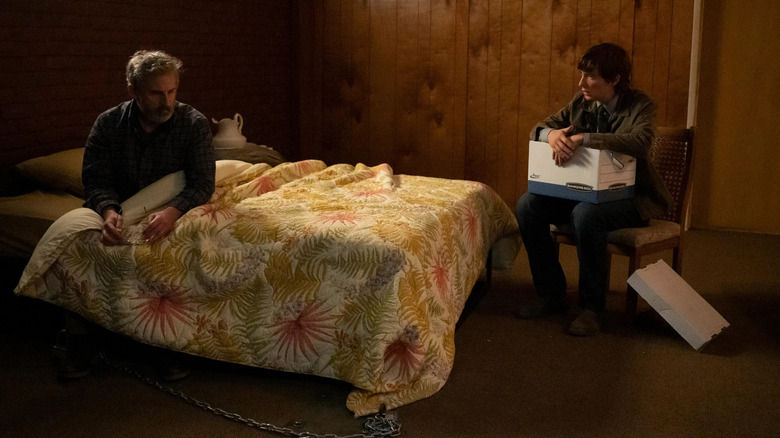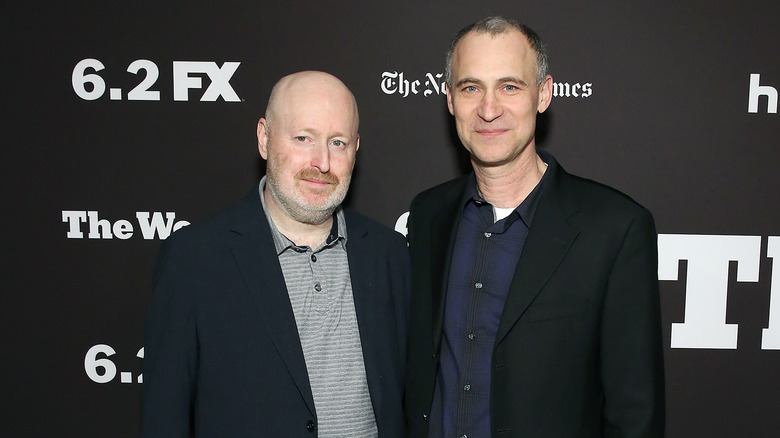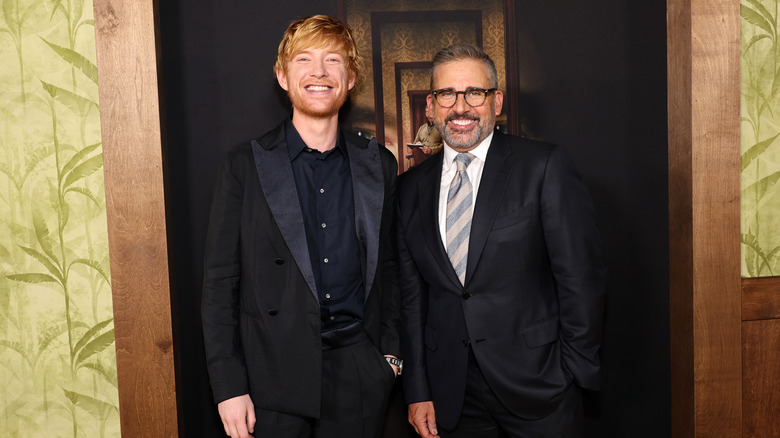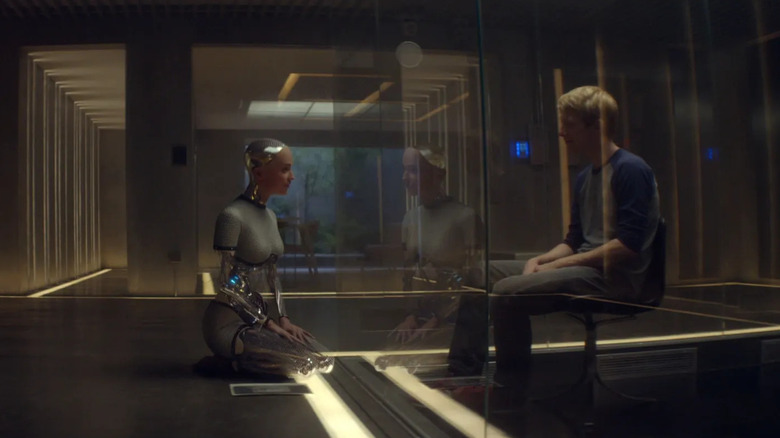The Untold Truth Of The Patient
With the right team of actors and writers, even a simple premise for a story can be highly engaging and entertaining. "The Patient" is an excellent example of this, as the show centers on just two main characters — a therapist and a severely troubled patient who kidnaps him in order to stop his sick habit of murdering people. More characters are thrown into the mix as the story develops, but it is the captivating interactions between leading stars Steve Carell and Domhnall Gleeson that really drive the tale.
From the brilliant minds of Joe Weisberg and Joel Fields, the showrunners of "The Americans," this latest creation of theirs retains much of the tension associated with "The Americans" but at a disturbingly slow pace. Gleeson's character sparks true terror, as we never know when his wrath will erupt into violence. Meanwhile, the audience can sense the desperation in Carell's character trying to figure out how to save himself as he also struggles with his own inner demons. Details from behind the scenes only reinforce the notion that a lot of dedication went into this production — a notion that the 10-episode limited series already makes plainly obvious.
Personal therapy sessions inspired the showrunners
After finishing their hit drama series, "The Americans," Joel Fields and Joe Weisberg were ready to collaborate on their next project. As the duo brainstormed over different topics for their new story to center on, they tried to think about anything that would fascinate both of them, leading to the creation of "The Patient." Weisberg told Newsweek, "We started talking about the fact that we both had a lot of therapy and we thought therapy is really interesting and important in our lives and therefore theoretically something you should write about."
Both of them have much respect for the treatment and praise its benefits, but as Fields explained to Collider, they realized a show only about therapy would not be exciting enough for most audiences, which is when the serial killer aspect was added to the developing tale. Yet, it did occur to Weisberg that the dark addition might be somewhat controversial in his own sessions. In an interview with USA Today, he admitted, "I did have to run [the idea] by my therapist, but I think I mostly just got a smile and a little bit of a chuckle. The subtext is too obvious to actually need exploration."
Joe Weisberg's characters start as blobs in his mind
Ever since news of "The Patient" was released, the project has been closely associated with Steve Carell. This might lead you to believe the creators had him in mind as the protagonist from the beginning, but that was not the case. In an interview with Collider, Weisberg said, "It's an interesting thing because in Hollywood, there's a lot of 'Who do you picture?' and Joel and I never really thought that way. I don't know what he has in his head, but in my head, I have an amorphous blob for every person when we're writing. It's barely recognizable as human. I don't know if Joel has a blob." Fields then joked that in his mind they are not blobs, but cotton candy.
The character of therapist Alan Strauss was already written when the showrunners found out that Carell wanted to collaborate on something, and it did not take long for them to realize that the actor would be perfect for the part.
The series creators incorporated their Jewish heritage
Similar to how the showrunners made therapy a central aspect of "The Patient," Joel Fields and Joe Weisberg incorporated other important parts of their private lives into the show as well. A major example was writing the protagonist, Alan Strauss, and his family as Jewish in the development of the characters. Both of the creators grew up in Jewish families, and that heritage made an impact on Fields, especially because his father was rabbi. As Weisberg explained to Newsweek, by having Alan have such a relatable background, it gave the duo a very clear view into the mentality behind his actions.
The showrunners were aware that the casting of Steve Carell for the role may upset some viewers since he is not Jewish, but that was not a concern for the writers of the show. Weisberg told Variety, "I think our feeling has always been, as television writers, that we're kind of in an area where people are pretending to be other people. That's what everyone does all the time. And that's just our main outlook on it. But we understand some people feel differently about it and that is also fine, too. But that's where we were coming from."
The unique characters attracted the lead stars to the project
When Domhnall Gleeson read the script of "The Patient," it was instantly important to him that the serial killer character he would play was not portrayed in an all-too-common Hollywood fashion. In an interview with Decider, he explained, "There's a really bad version of that show that's quite schlocky and that is all about the mythologizing of the serial killer and this sexy, strange guy who's intriguing in a way that, you know, I find a little bit distasteful. I don't like that version of things. And there's been a lot of it."
Upon discovering that his character, Sam, was not like that, it made Gleeson appreciate the story so much because to him it was a more appropriate way to deal with the dark subject matter. As an added bonus, the more he read, the more intrigued he became, especially in the realization that he had never played a role like that before. Likewise, Steve Carell told USA Today that he was fascinated with the way that the two main characters interact as the series progresses because he was often unable to predict what would happen.
Steve Carell previously played a therapist in Hope Springs
Not that the actor needed it to get hired for his role in "The Patient," but Steve Carell had experience in a somewhat similar role for the 2012 film, "Hope Springs." In the romantic comedy, Carell played the marriage counselor to Meryl Streep and Tommy Lee Jones.
In an interview with Fandango, Carell explained how he prepped for the 2012 part, saying, "I met with a few therapists, and I kind of modeled it after one guy who — it wasn't a put-on voice, that's the way I'm sure he always talks. But there was such a kindness and soothing quality to it that I thought, 'That's the guy who would be helpful to these two!'" But regardless of the similarities between his parts in the two films, the actor pointed out one key difference when talking to USA Today. About his previous therapist role, he stated bluntly, "The stakes weren't quite as high."
Sam the serial killer has the same interests as the show creators
For "The Patient," Joe Weisberg and Joel Fields used their own backgrounds to develop both main characters. Sam has an obsessive nature throughout the series, not only concerning murder, but also with his two favorite hobbies — eating delicious food and listening to Kenny Chesney music. The showrunners are deeply familiar with both subjects because they happen to be fans themselves. Everyone enjoys eating, of course, but it's a deliberately cultivated palate and intellectual curiosity about food that differentiates people who like food from real foodies like Sam the homicidal maniac.
Sam's interests more so reflect those of Weisberg, as he revealed to USA Today. Apparently, he considers himself an unofficial member of the "No Shoes Nation," the name for the group of diehard fans of Kenny Chesney. And while Fields admitted he does enjoy great meals, or even just conversing about food, he also told Collider that his co-creator is more of a foodie than he is.
Domhnall Gleeson could not take all the caffeine
Throughout "The Patient," Sam the serial killer has several obsessions. Along with food, Kenny Chesney, and murder, Domhnall Gleeson's character also cannot get enough coffee from Dunkin' and he is often seen downing the beverage. His coffee addiction is further emphasized by how many times he needs to take bathroom breaks and the amount of time it takes for him to relieve himself as Carell's character awkwardly waits. In fact, Sam drinks so much Dunkin' in his scenes that Gleeson was forced to modify the drink going forward.
During a chat with Decider, the actor had to be honest and said, "When we were filming, I went decaf, I should point out. And we didn't do decaf for the first take, and I was like, 'Oh my god. Like, I cannot do anymore takes like that.' I was shivering with caffeine."
Steve Carell wore the shackles off-camera
From the very beginning of "The Patient," a major feature of the story is how Steve Carell's character is shackled to a bed to prevent him from escaping from his serial killer patient, Sam. And just like Alan, Carell was actually locked into his manacles during filming, but was much more fortunate in that the props guy would eventually release him at the end of the shoot. The actor also made sure that a spare key was always within reach because the possibility that he might get trapped in an emergency was too scary to risk.
Yet even though Carell was never a real captive, he did admit that the production was rough, especially at first. He told the New York Times, "The physicality of it was more than I expected. It was instantly claustrophobic to know that I had a span of about 10 feet to move for about three months of work. You couldn't move too fast or you'd cut your ankle — I found that out pretty quickly."
As a true master of his craft, Carell tried his best to understand how his character would have felt chained up at all times, so he even wore the manacles when he did not have to. The actor revealed to USA Today, "Even when I was off camera, I put it on because it just felt different." Not only did that give him a good perspective to play the captive, but oddly enough, he even began to feel comfortable wearing the shackles.
Psychotherapist Dennis Palumbo worked as a consultant
As both advocates for and beneficiaries of therapy, Joel Fields and Joe Weisberg initially used their own experiences as they began to write "The Patient." Furthermore, the showrunners were diligent in doing their own research as well with books, articles, and documentaries, especially about the psychology of murderers. But to really flesh out the story, they eventually made sure to consult with an expert to get as accurate with the subject matter as possible. Due to several logistical and ethical problems, they did not attempt to consult with a real serial killer, opting instead to take the safer route and bring an actual therapist into the production.
For help, the creators turned to licensed psychotherapist Dennis Palumbo who was brought on for his educated perspective and became a co-producer of the project, too. When talking with Newsweek, Fields added, "He's also a writer, he's written some extraordinary books about writing from a therapeutic point of view, and you know all of that sort of came together for us in these characters really."
Steve Carell and Domhnall Gleeson got along really well
Before "The Patient," Steve Carell and Domhnall Gleeson had never worked together, but the experience ended up being highly positive on a personal level for both of them. Gleeson revealed to Decider that even before he was hired, one of his main motivations to join the project was the opportunity to work with Carell, but it turned out better than what he hoped for. He said, "Even though my expectations were so high of working with [Carell], even still, he managed to surpass them just by being such a gorgeous person. Such a kind person. Being so nice to be around. And then being so great in the show and being so great on-camera and off-camera."
Likewise, Carell knew right away that they no longer had to look for his co-star when Gleeson arrived. He told The Wrap, "It was instant. After the first scene, it was clear that he was the right person for that role. There was a chemistry. I can't remember having a better working experience with another actor."
The two actors were not the only ones very pleased with the casting. As Joe Weisberg and Joel Fields watched Gleeson read lines together for the first time, the creators quickly sensed a similar vibe to how Keri Russell and Matthew Rhys worked so well together in their previous hit series, "The Americans" (via Yahoo! Entertainment).
Filming The Patient was similar to Ex Machina for Domhnall Gleeson
Working on "The Patient" was a unique experience for Domhnall Gleeson in one fascinating way. The actor revealed to the New York Times that he was often told to decrease the speed of his dialogue to improve scenes, which is a direction he was not at all used to receiving.
On the other hand, the experience reminded Gleeson of one other project he had appeared in — the 2014 psychological thriller "Ex Machina." Because of the similarities between the two productions, Salon asked him if filming the new show brought back those memories and he responded, "A couple times it did come up, when we talked about just the notion of like, 'Oh, my God, these are really long scenes. Have you ever done this many long scenes in a row before, with one other actor?' They're these really intense, not interrogations, but you know, manipulation and control, all that stuff going on. And 'Ex Machina' was the only one that I had to compare it to."
The dark humor was not overlooked
Even though the subject matter is very serious in "The Patient" and was approached that way by the creators of the show, there were moments of surreal, dark humor that would sometimes cause the actors to break character and laugh. When talking with the New York Times, Carell explained, "It's certainly not a comedy. But in table reads, we'd be laughing out loud because these comedic moments were juxtaposed with the most horrific things going on in these people's lives."
During those moments, it was healthy for the mood to be lightened occasionally for the cast and crew. But the actors were also encouraged to improvise with dark humor if they felt it worked in the scene. Domhnall Gleeson discussed how well this worked with Carell and said, "It felt very comfortable to offer up something which was a little dangerous in terms of maybe the comedic aspect or the intensity of the emotion because he's always just right there."
